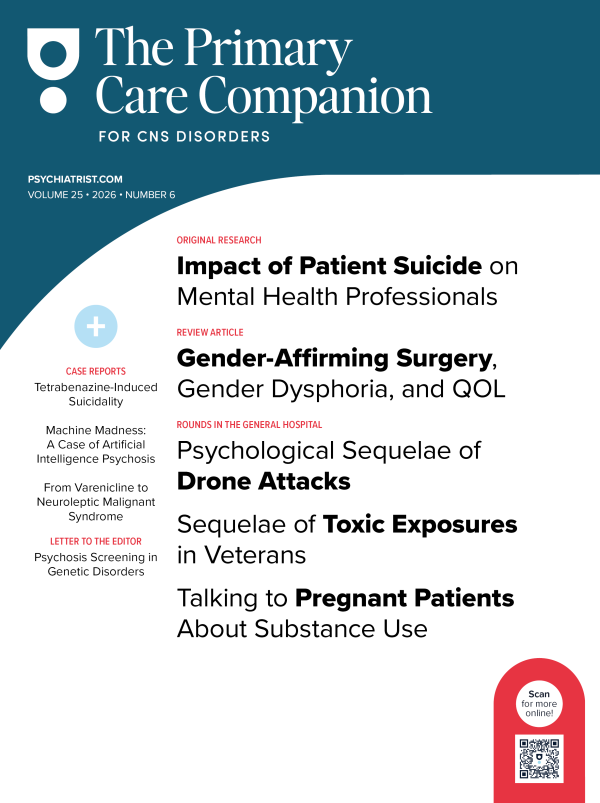Because this piece does not have an abstract, we have provided for your benefit the first 3 sentences of the full text.
To the Editor: Behavioral and psychological symptoms of dementia affect more than 90% of patients diagnosed with dementia. The symptoms create a significant barrier to caring for patients with dementia and constitute the main reason for institutionalization. A variety of pharmacologic interventions have been utilized to manage behavioral and psychological symptoms of dementia, and while antipsychotics remain a preferred option, they are associated with significant risks in patients with dementia.
Nabilone for the Treatment of Dementia-Associated Sexual Disinhibition
To the Editor: Behavioral and psychological symptoms of dementia affect more than 90% of patients diagnosed with dementia.1 The symptoms create a significant barrier to caring for patients with dementia and constitute the main reason for institutionalization.2 A variety of pharmacologic interventions have been utilized to manage behavioral and psychological symptoms of dementia, and while antipsychotics remain a preferred option, they are associated with significant risks in patients with dementia.3 Agitation and sexual disinhibition remain particularly problematic to treat.4
Case report. Mr A, a 71-year-old man with mixed vascular and frontotemporal dementia, was first diagnosed with dementia-related memory and behavioral changes (DSM-IV criteria) in 2005. Contributory comorbid medical diagnoses included a stroke in 2005 and acute brain injury following a motor vehicle accident in 2006. Mr A was a resident at a long-term care home, as his wife was no longer able to care for him on her own. The disease progressed with the development of significant behavioral and psychological symptoms of dementia, particularly manifested as sexual disinhibition including inappropriate sexual comments, touching nursing staff, public masturbation, and seeking out female residents. Attempts to curb his behaviors over the last 5 years included nonpharmacologic interventions as well as trials of sertraline, divalproex, trazodone, risperidone, and aripiprazole. Unfortunately, the behaviors continued, and Mr A was admitted to the inpatient psychiatric ward in an attempt to manage his sexual disinhibition.
At admission, all psychotropic medications were stopped, and Mr A was prescribed 1 mg of lorazepam when necessary for agitation. Behavior at admission included groping of the nursing staff as well as inappropriate sexual remarks. No withdrawal symptoms were observed.
Six days after admission, Mr A was started on nabilone 0.5 mg every 12 hours and risperidone 0.5 mg when necessary for aggressive behavior. On day 8, the dose of nabilone was increased to 1 mg every 12 hours, which resulted in a significant improvement in behavioral symptoms. Reports from nursing staff, physicians, and family validated a complete resolution of sexual disinhibition symptoms. Progress notes illustrated that symptoms had, for the most part, subsided. Unfortunately, on day 14, Mr A became delirious and lethargic. This was attributed to a likely drug interaction with the patient’s nonpsychotropic medications or less likely an adverse reaction to the medication. The nabilone was held for 48 hours. There was no evidence of symptom reemergence during this 48-hour period most likely because Mr A’s acute illness prevented proper expressiveness.
Once medically stable, nabilone was restarted on day 16 at 0.5 mg every 12 hours and subsequently increased to 0.5 mg every 8 hours the following day. Mr A was stable at this dose; the dose provided good control of behavioral and psychological symptoms of dementia and was well-tolerated. However, after being stable on nabilone 0.5 mg every 8 hours for 10 days, Mr A again became increasingly sedated and lethargic, which is a common side effect of nabilone. The medication was held in an effort to curb the sedation (day 28). Mr A returned to his long-term care home 30 days after being admitted to the hospital. After returning to the long-term care facility, the behaviors of sexual disinhibition recurred quickly.
Unfortunately, due to a transcribing error, following his discharge to the long-term care facility, Mr A’s nabilone dose was not restarted; this led to a resurgence of sexual disinhibition at the nursing home. Nabilone was restarted at 0.5 mg every 12 hours after a 5-day off period. The dose was subsequently increased to 0.5 mg every 8 hours 6 days later. At 3-month follow-up, general behavioral and psychological symptoms of dementia and specifically sexual disinhibition symptoms remain significantly improved on this dose of 0.5 mg every 8 hours. It is unclear why the current dose regimen of 0.5 mg every 8 hours is maintaining good symptom control with no the lethargy and sedation as was seen on day 28. Clearly, Mr A is now in a more mentally stimulating environment at his long-term care facility. We can only speculate that this interactive and encouraging environment may be helping to curb symptoms of lethargy.
Synthetic oral cannabinoids are being used to treat pain, chemotherapy-associated nausea/vomiting, anorexia due to human immunodeficiency virus/acquired immunodeficiency syndrome and chemotherapy treatments, symptoms of multiple sclerosis, and anxiety.5,6 There is growing evidence that synthetic cannabinoids are effective treatment options for behavioral and psychological symptoms of dementia. The cannabinoid receptor agonist dronabinol was found to improve anorexia and agitation7 as well as nocturnal agitation8,9 in Alzheimer’s disease patients. Moreover, the cannabinoid receptor agonist nabilone has been shown to reduce the severity of dementia-related agitation in Alzheimer’s dementia10,11 and frontotemporal dementia patients.10
The mechanism by which synthetic cannabinoids exert their effects remains unknown. The link between the cannabinoid pathway and dementia has been evidenced by disease-modifying properties of cannabinoid agonists in Alzheimer’s type dementia. These interesting properties include antiglutaminergic effects, anticholinesterase inhibition, antioxidant and anti-inflammatory properties, reduced β-amyloid deposition, stimulation of β-amyloid phagocytosis, and reduced neuronal exitotoxicity.12,13 Moreover, brains from patients with dementia have significant alterations in components of the cannabinoid system.12,13 Manipulation of the cannabinoid system may provide beneficial neuroprotective results in the treatment of Alzheimer’s disease.
In this report, nabilone at 0.5 mg every 8 hours was shown to improve sexual disinhibition associated with dementia in a patient who was refractory to other treatment modalities. While, synthetic cannabinoids have been effective in the treatment of dementia-associated aggression and agitation, this is the first report establishing the effects on sexual disinhibition specifically. In this case, the beneficial effects of nabilone were detectable in as little as 48 hours. This prompt and dramatic response to nabilone has been shown before in the treatment of dementia-associated aggression and resistance to care.11 Absorption of nabilone peaks 2 hours after administration and has a half-life of 2 hours. It is metabolized by P450 isoenzymes, and has been shown to be a weak inhibitor of CYP2E1 and CYP3A4 and a moderate inhibitor of CYP2C8 and CYP2C9.14 The manufacturers propose that the low plasma concentrations observed in clinical use are unlikely to interfere with the metabolism of coadministered medications also metabolized by P450 enzyme isoforms. But, nabilone is highly bound to plasma proteins, which may displace other protein-bound drugs and affect their efficacy.15
Current standards of care in the pharmacologic treatment of behavioral and psychological symptoms of dementia include 2 broad classes: antipsychotics and nonantipsychotics, such as memantine, cholinesterase inhibitors, and antidepressants. Health care providers often hesitate to use antipsychotics due to their adverse side effect profile.3 The use of the nonantipsychotics, while effective and with fewer adverse effects, often involve gradual dose titration, resulting in a delayed onset of clinical response.
Mr A did experience sedation and lethargy while titrating the dose of nabilone, which is a common side effect of synthetic cannabinoids. This finding reinforces the importance of slowly titrating cannabinoids until clinically relevant improvements are observed. The most efficient dose for Mr A was 0.5 mg every 8 hours. Similar dosing was effective for aggressive behavior in a patient with frontotemporal dementia.10 The brief period of delirium and lethargy experienced by our patient on day 8 of treatment may have been the result of an adverse effect to nabilone, but a more likely explanation is that the highly protein-bound properties of nabilone16 resulted in a drug interaction with the patient’s other medications. This drug interaction was precipitated by an elevated dose of nabilone at 1 mg every 12 hours.
This case provided a unique and inadvertent opportunity to study the discontinuation and reintroduction of nabilone. While discontinuations of nabilone were either necessary due to medical instability or accidental, we were able to demonstrate the prompt return of undesirable symptoms (less than 48 hours) following discontinuation and the rapid onset of action when reintroduced, resulting in symptom resolution in as little as 48 hours.
Our report demonstrates the efficacy of nabilone in the treatment of sexual disinhibition in a patient with mixed-type dementia. This report further suggests that there may be a role for the use of synthetic cannabinoids in the treatment of behavioral and psychological symptoms of dementia. Large-scale clinical trials are necessary to determine clinical efficacy.
REFERENCES
1. Lyketsos CG, Lopez O, Jones B, et al. Prevalence of neuropsychiatric symptoms in dementia and mild cognitive impairment: results from the cardiovascular health study. JAMA. 2002;288(12):1475-1483. PubMed doi:10.1001/jama.288.12.1475
2. Banerjee S, Murray J, Foley B, et al. Predictors of institutionalization in people with dementia. J Neurol Neurosurg Psychiatry. 2003;74(9):1315-1316. PubMed doi:10.1136/jnnp.74.9.1315
3. Schneider LS, Dagerman K, Insel PS. Efficacy and adverse effects of atypical antipsychotics for dementia: meta-analysis of randomized, placebo-controlled trials. Am J Geriatr Psychiatry. 2006;14(3):191-210. PubMed doi:10.1097/01.JGP.0000200589.01396.6d
4. Buhr GT, White HK. Difficult behaviors in long-term care patients with dementia. J Am Med Dir Assoc. 2006;7(3):180-192. PubMed doi:10.1016/j.jamda.2005.12.003
5. Ben Amar M. Cannabinoids in medicine: a review of their therapeutic potential. J Ethnopharmacol. 2006;105(1-2):1-25. PubMed doi:10.1016/j.jep.2006.02.001
6. Kumar RN, Chambers WA, Pertwee RG. Pharmacological actions and therapeutic uses of cannabis and cannabinoids. Anaesthesia. 2001;56(11):1059-1068. doi:10.1046/j.1365-2044.2001.02269.x PubMed
7. Volicer L, Stelly M, Morris J, et al. Effects of dronabinol on anorexia and disturbed behavior in patients with Alzheimer’s disease. Int J Geriatr Psychiatry. 1997;12(9):913-919. PubMed doi:10.1002/(SICI)1099-1166(199709)12:9<913::AID-GPS663>3.0.CO;2-D
8. Walther S, Mahlberg R, Eichmann U, et al. Delta-9-tetrahydrocannabinol for nighttime agitation in severe dementia. Psychopharmacology (Berl). 2006;185(4):524-528. PubMed doi:10.1007/s00213-006-0343-1
9. Walther S, PubMed Sch×¼pbach B, Seifritz E, et al. Randomized, controlled crossover trial of dronabinol, 2.5 mg, for agitation in 2 patients with dementia. J Clin Pharmacol. 2011;31(2):256-257. doi:10.1097/jcp.0b013e31820e861c
10. Amanullah S, MacDougall K, Sweeney N, et al. Synthetic cannabinoids in dementia with agitation: case studies and literature review. Clinical Neuropsychiatry. 2013;10(3-4):142-147.
11. Passmore MJ. The cannabinoid receptor agonist nabilone for the treatment of dementia-related agitation. Int J Geriatr Psychiatry. 2008;23(1):116-117. PubMed doi:10.1002/gps.1828
12. Campbell VA, Gowran A. Alzheimer’s disease; taking the edge off with cannabinoids? Br J Pharmacol. 2007;152(5):655-662. PubMed doi:10.1038/sj.bjp.0707446
13. Orgado JM, Fernסndez-Ruiz J, Romero J. The endocannabinoid system in neuropathological states. Int Rev Psychiatry. 2009;21(2):172-180. PubMed doi:10.1080/09540260902782828
14. McGilveray IJ. Pharmacokinetics of cannabinoids. Pain Res Manag. 2005;10(suppl A):15A-22A. PubMed
15. Cesamet [package insert]. Quebec, Canada: Valeant Pharmaceutical International; 2006. http://dailymed.nlm.nih.gov/dailymed/drugInfo.cfm?setid=a7a2a4e1-9ecd-4e59-82b5-2068b5e50164
16. Grotenhermen F. Pharmacokinetics and pharmacodynamics of cannabinoids. Clin Pharmacokinet. 2003;42(4):327-360. PubMed doi:10.2165/00003088-200342040-00003
Author affiliations: Schulich School of Medicine and Dentistry, Western University, London (Mss Zajac and Sikkema); and Chatham-Kent Health Alliance, Mental Health and Addictions Program, Chatham (Dr Chandrasena), Ontario, Canada.
Potential conflicts of interest: None reported.
Funding/support: None reported.
Published online: February 19, 2015.
Prim Care Companion CNS Disord 2015;17(1):doi:10.4088/PCC.14l01695
© Copyright 2015 Physicians Postgraduate Press, Inc.
Please sign in or purchase this PDF for $40.00.




